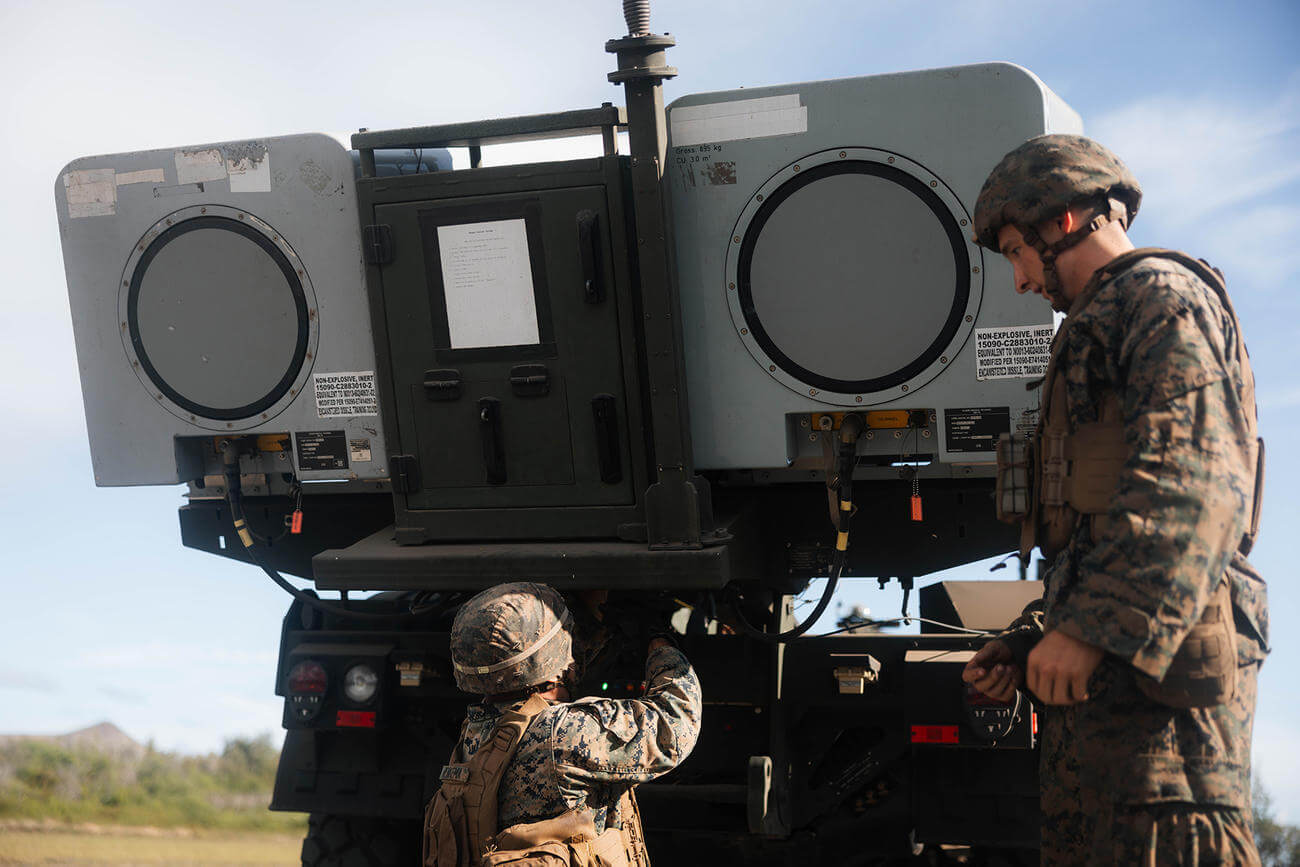
Marines on Oahu are the first in their service to officially receive a new “ship-killing” missile system they hope will give American forces an edge in the Pacific.
They have been testing the Navy/Marine Corps Expeditionary Ship Interdiction System, better known as NMESIS, and are eager to add it to their arsenal. Members of the 3rd Marine Littoral Regiment held a ceremony in November at Dewey Square on Marine Corps Base Hawaii to celebrate getting their hands on the missile launchers.
Lt. Col. Timothy Love, commanding officer of the regiment’s 3rd Littoral Combat Team, told attendees that upon receipt of the NMESIS weapon system, the regiment “has an enhanced sea denial capability and is positioned at the forefront of strategic transformation.”
The Marine Corps is in the midst of an ambitious makeover, shifting from previous decades of fighting land battles in the Middle East against insurgents to return to its roots as a naval fighting force focused on island and coastal operations. The Marines call the initiative Force Design 2030.
The 3rd Marine Littoral Regiment is the first unit to be reorganized and is intended to serve as a blueprint for what the rest of the Corps will look like. Love said the arrival of NMESIS “deepens naval integration and strengthens deterrence by providing coverage from coastal positions, extending the joint force’s ability to target and engage from both land and sea.”
The vehicle-mounted NMESIS launchers are designed to move quickly to different positions to set up missile-launching batteries. A regiment spokesperson told the Honolulu Star-Advertiser that while the new launch system is now on-island, the actual missiles themselves are not here yet.
Elements of the 3rd Marine Littoral Regiment are training to deploy to the Western Pacific in 2025. When asked whether they would be bringing NMESIS along with them, the spokesperson said, “Unfortunately, the planning for deployment is still ongoing, and it is too early to know if the NMESIS will be deployed with the unit.”
Missiles are a key part of the vision Marine Corps leaders have for Force Design 2030.
The architects of Force Design 2030 envision groups of Marines spreading out and setting up positions along island chains and atolls using missiles, drones and other high-tech tools to fire on enemy ships and hold on to critical strategic island and coastal positions in support of the Navy and American allies.
The Marines tested NMESIS prototypes during the summer of 2021 at the Pacific Missile Range Facility on Kauai, launching two of the missiles at a decommissioned Navy frigate 60 miles offshore as they practiced quickly getting into position to set up the missiles and launch at passing enemy ships before they could be detected.
“Moving the NMESIS from the category of initial test and operational evaluation to a fielded weapon system is a significant milestone for 3rd MLR,” the regiment’s commander, Col. John Lehane, said in a statement. “The NMESIS provides this Regiment a potent sea denial capability in support of our mission essential task to attack enemy maritime targets.”
Force Design 2030 was crafted to reflect what Marine Corps leaders believe a potential conflict in the Pacific would look like, with a special focus on the disputed South China Sea — a critical waterway through which at least one-third of all international trade moves.
Nearby island chains also would play a role if China were to invade Taiwan, a self-ruled island democracy that Beijing considers a rogue province.
Beijing considers the entire waterway its exclusive sovereign territory, over the objections of its neighbors. The Chinese military has stationed troops on disputed reefs and built more than two dozen artificial islands — some with landing strips — to consolidate their position.
The Marines’ new strategy seems tailored in part to fight over these disputed islands and reefs.
But Force Design 2030 has been controversial. The 3rd Marine Littoral Regiment got rid of all of its conventional cannon-based artillery pieces to use NMESIS. The Marine Corps also phased out its entire inventory of tanks.
Critics have charged that the emphasis on missiles and drones will put Marine Corps infantry in the role of mostly protecting those assets instead of attacking the enemy, gradually eroding the service’s famed culture of aggression. Retired Marine officers have expressed concerns that the new posture will ultimately put troops into exposed positions that could get hundreds — if not thousands — of young Marines killed if the tactics were used in a real conflict.
But the new vision also has ardent defenders. In January a group of currently serving and former Marine Corps officers penned an article at War on the Rocks — an influential website focused on national security issues — emphasizing recent events in Ukraine and in the Red Sea where combatants have used missiles and drones to sometimes devastating effect against their opponents.
The Marine officers wrote that “the broad lessons from the Black Sea and Middle East directly apply to the Indo-Pacific.”
Nevertheless, while U.S. leaders have said they want to be able to fight and win a Pacific conflict, they also insist that they hope that by demonstrating their capabilities and strengthening alliances, they will ultimately prevent any war.
Over the past year, U.S. and Chinese diplomats have been working to cool tensions. U.S. military leaders have also sought talks with their Chinese counterparts.
In September, Gen. Wu Yanan, the Chinese military commander responsible for operations in the South China Sea, attended a meeting of top military leaders held in Hawaii and met with Adm. Samuel Paparo, commander of all U.S. forces in the Pacific. U.S. officials characterized it as a positive sign nearly two years after Beijing cut off most dialogues between U.S. and Chinese military commanders.
But just after the visit, the Chinese military tested a ballistic missile that landed in the Pacific Ocean south of Hawaii in between Kiribati and French Polynesia. Chinese officials sent a notification to U.S. and French officials in advance of the launch but did not inform the leaders of Pacific island nations. While U.S. officials said notifications were a positive step, officials in Kiribati condemned the Chinese launch.
The election in November that brought former President Donald Trump back to power has raised questions about the future of American foreign policy. Trump is known for his tough stances on China and has tapped Rep. Michael Waltz, R-Fla., a retired Green Beret who has built a reputation as a vocal China hawk, to serve as White House national security adviser.
As part of the transition, Waltz has been holding discussions with President Joe Biden’s National Security Adviser Jake Sullivan.
“Jake Sullivan and I have had discussions ; we’ve met,” Waltz told Fox News on Nov. 24. “For our adversaries out there that think this is a time of opportunity, that they can play one administration off the other — they are wrong. … We are hand in glove. We are one team with the United States in this transition.”
(c) 2024 The Honolulu Star-Advertiser
Visit The Honolulu Star-Advertiser at www.staradvertiser.com
Distributed by Tribune Content Agency, LLC.
© Copyright 2024 The Honolulu Star-Advertiser. All rights reserved. This material may not be published, broadcast, rewritten or redistributed.


















